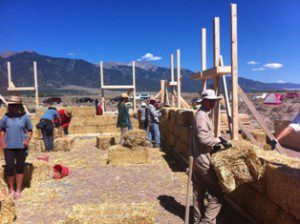
For example, a small window can bring in light and add character to a building just as easily as a large one. The key is in the placement and the finish. Be sure to really pay attention to where the window is placed so that the optimum amount of light and view will be gathered. When finishing the window, be sure to flare the interior to allow the most light to penetrate the room.
The placement of windows in load bearing structures has an advantage over post and beam or other framed examples. That advantage is the fact that the window buck is not placed until much of the wall is already built. This allows the builder to really see what the view will be like with a solid wall in place. Instead of imagining what the room will be like once filled in, one can see it in real time as the window is placed. That way, the exact location is easier to determine when considering light infiltration and view.
Have fun with windows in load bearing structures. Place them properly and let them become a main force in the character of your building. Don’t get stuck in the box, create a new box with as many sides as you want! Have fun!



5 Responses
I would like to incorporate as much glass in the south facing wall as possible! for this reason I have gone away from the load bearing system and am looking at post-beam. In your experience is there a suitable distance between windows? ie. one bale or should I be grouping windows and then putting in a larger section of bales ??
Ryan,
It is easiest to simply frame the windows close together so that the space in between them can be covered with trim. If you put too big a space, you will have to plaster it. If you do go towards a bigger space, make sure it is big enough to get a solid section of plaster in there, one foot minimum is best. Good luck and have fun!
Andrew
The thing is, I am entirely new to the whole arena of load bearing structures.. Do you mean that if I have a load bearing structure then the size of my window will not be too large? That’s how it should be, right?
I’m struggling to find any details about exactly how large is too large for load-bearing straw bale windows. I know that openings must be at least one bale from corners, and I know that the total opening width must not exceed 50% of the internal length of the wall.
However..:
> What is the maximum *individual* window size?
> Is there a minimum gap between windows and doors, such as 1 bale, for example?
> Does the vertical height of openings matter? Obviously a door is full-height, but I assume the main considerations are in terms of width for windows.
Hi Mark. This is a great question and one that is best handled by an engineer. Unfortunately, there are so many factors that come into play (snow loads, wind loads, height of wall, density of bales, etc.) that a general answer is difficult or impossible to provide. The space in between windows will also depend on the engineering. For example, if there is only a single column of bales, most engineers are not likely to include that as part of the wall system, but rather as part of the opening since it won’t provide a lot of load path or shear strength.
I wish I had a better, more simple answer for you.